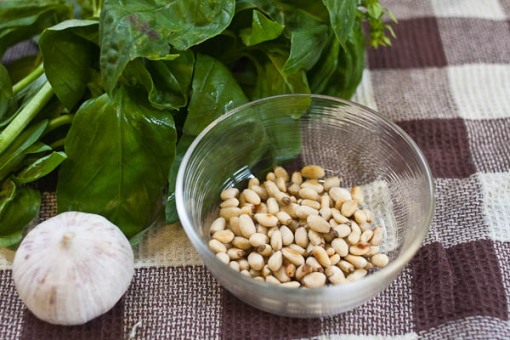
Making your own pesto is much faster and easier than you'd expect
Most people don’t seem to think of pesto as a quick meal, unless you’re dolloping it out of a jar. Actually, though, fresh pesto is fast, simple, nutritious, and much, much tastier than any jar version you might have tried – even better than most restaurant versions.
I first encountered pesto from my Italian aunt, who used to babysit me until I was three years old. I then promptly forgot about it, of course, until a friend reintroduced me about sixteen or so years later. It surprised me to find out that most people think of pesto as something that comes out of jars. It’s actually very quick and easy to make at home – and so very much tastier than anything you’ll find in a jar.
There are many varients of pesto. I generally make a couple of different version, depending on what I have on hand. Basil pesto is my favourite, but you can also make very tasty versions from parsely or coriander. As well as using them on pasta, you can put dollops into soup, or on baked or grilled vegetables, into sandwiches, or as a salad dressing – or anywhere else you want a fresh tang of herbs and parmesan.
If you have a food processor, you can go from herbs on stalks to pesto in about 10 minutes, or less if you’re skipping the toasted pine nuts. If you only have a mortar and pestle, it may take a little longer – but some people think it’s even more delicious.
I’ve always read that pesto made in a mortar and pestle tastes much better than the food-processor made stuff. So just to keep things interesting, I made this pesto two ways. One in the food processor, the other in the mortar.
Basil pesto
The fresher the basil, the better the pesto. Make sure you don’t use the flower heads in your basil; they’ll make your pesto bitter. And remember, all the quantities in this recipe are approximate, feel free to modify them to your taste.
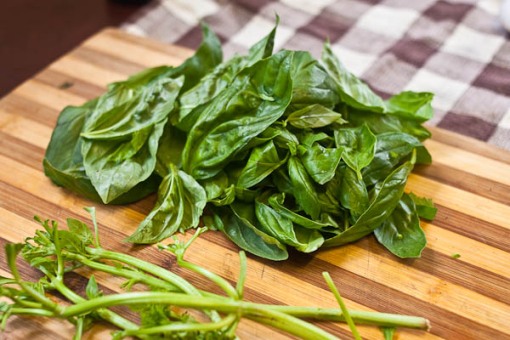
Make sure you leave out the flower heads, or you'll end up with bitter pesto
Ingredients
1 bunch of fresh basil
a handful of pine nuts
1/4 cup of parmesan, grated
1-2 cloves of garlic, peeled
about 2 tablespoons to 1/4 cup olive oil
Pinch of sea salt
Extra parmesan, to serve (optional)
Method
Pluck the leaves from the basil, and put in your food processor (or mortar). Toast the pinenuts in a dry frypan until they start to turn golden brown – watch them carefully as they can burn quickly. Pop them into the food processor as well, along with all the other ingredients (start with the smaller amount of olive oil). If you’re using a mortar and pestle, slice the garlic finely to make it easier to pound. Process your pesto until it becomes a very rough paste, either in a food processor or by giving it a good pounding with the pestle. Add more olive oil as needed.
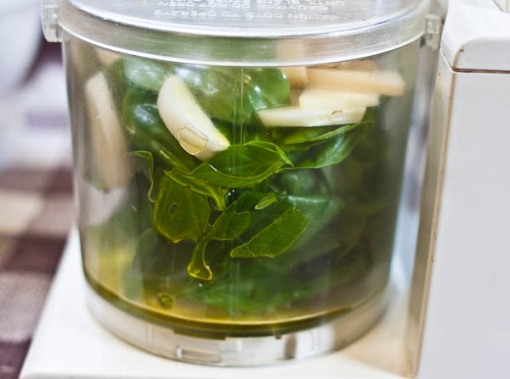
Process until you get a chunky paste, adding more olive oil as needed
Serve tossed through fresh-cooked pasta, with a sprinkling of extra parmesan, if you feel like it.
Serves 2 hungry people.
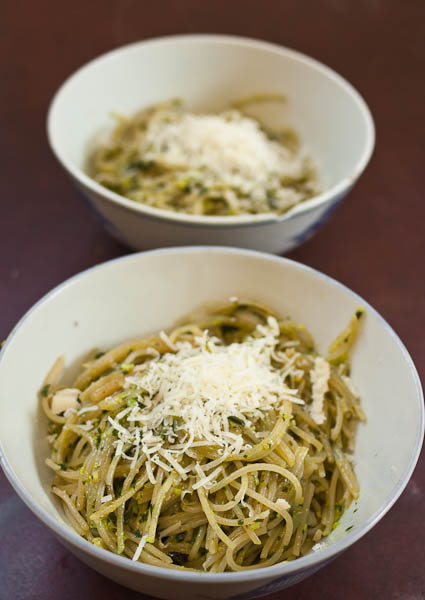
Serve with a little extra parmesan, or just as is.
So which version is tastier? M and I sampled each, and the version made in the mortar won hands down. It had a more complex flavour, with the basil coming through much more clearly.
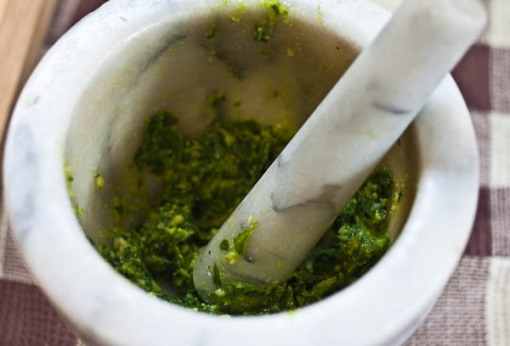
The pesto made by hand had much more flavour and depth than the food processor batch
Does this mean I’ll be pounding my pesto from now on? I doubt it – it’s too labour-intensive for a fast meal. I may tip it into the mortar at the end, but the difference in flavour wasn’t large enough to make the extra effort worthwhile, except for extra-special occasions.
